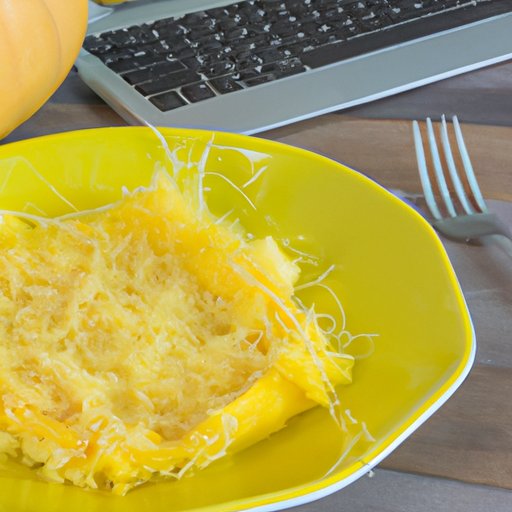Introduction
Are you looking for a delicious and healthy addition to your diet? Spaghetti squash is a versatile vegetable that can provide numerous health benefits. However, many people aren’t sure about how many calories are in spaghetti squash and may not know how to prepare it. In this article, we will explore the nutritional value of spaghetti squash, how to cook it, compare it to pasta, and provide some tasty recipes.
Benefits of Adding Spaghetti Squash to Your Diet
Spaghetti squash is a low-calorie and nutrient-dense vegetable that is rich in vitamins and minerals. One cup of cooked spaghetti squash contains 42 calories, 0.4 grams of fat, and 10 grams of carbohydrates. Nutrients found in spaghetti squash include vitamin C, vitamin A, potassium, and dietary fiber.
Due to its low calorie and high nutrient content, spaghetti squash is an excellent addition to a healthy diet. It can help with weight loss, improve digestion, reduce inflammation, and strengthen the immune system.
How to Cook Spaghetti Squash for a Healthy Meal
Cooking spaghetti squash is easy, and it can be prepared in various ways such as baking, steaming, or microwaving. Here’s how to cook spaghetti squash:
- Preheat your oven to 400 Fahrenheit.
- Cut the spaghetti squash in half lengthwise and scoop out the seeds and pulp.
- Brush the inside of the squash with olive oil and season with salt and pepper.
- Place the squash halves cut-side down on a baking sheet and bake for 45-50 minutes.
- Once cooked, use a fork to scrape out the strands of squash.
Spaghetti squash can be used as a substitute for traditional pasta in recipes such as spaghetti squash carbonara or spaghetti squash lasagna. One serving size of spaghetti squash is one cup, which contains approximately 42 calories.
Spaghetti Squash vs Pasta
When compared to traditional pasta, spaghetti squash offers a lower calorie option with more nutrients. One cup of cooked spaghetti contains an average of 221 calories, 1.3 grams of fat, and 43 grams of carbohydrates. In contrast, one cup of cooked spaghetti squash contains 42 calories, 0.4 grams of fat, and 10 grams of carbohydrates. Additionally, spaghetti squash is an excellent source of vitamin A and potassium, while pasta is not a good source of any vitamins or minerals.
Choosing spaghetti squash over pasta can help with weight loss, improving digestion, and reducing inflammation. It is also a great option for individuals who need to manage their blood sugar levels.
Spaghetti Squash for Weight Loss
Spaghetti squash’s low calorie and high fiber content make it an excellent choice for weight loss. One cup of cooked spaghetti squash contains only 42 calories, while the same amount of pasta can contain over 200 calories. Additionally, the high fiber content in spaghetti squash can help individuals feel fuller for longer periods, which reduces overall calorie intake.
Spaghetti Squash Recipes and Their Calorie Count
Spaghetti squash is a versatile vegetable that can be used in numerous recipes, including vegan, vegetarian, and gluten-free options. Here are a few recipe ideas:
- Spaghetti Squash Carbonara – 1 cup of cooked spaghetti squash with 1/3 cup of carbonara sauce contains approximately 186 calories.
- Spaghetti Squash Lasagna – 1 cup of cooked spaghetti squash with 1/4 cup of tomato sauce and 1/4 cup of mozzarella cheese contains approximately 103 calories.
- Spaghetti Squash Pad Thai – 1 cup of cooked spaghetti squash with 2 tbsp of peanut sauce and a handful of chopped vegetables contains approximately 199 calories.
These recipes offer a delicious and healthy alternative to traditional pasta dishes, with fewer calories and more nutrients.
Conclusion
In conclusion, spaghetti squash is an excellent addition to a healthy diet that offers numerous health benefits. It is a low-calorie and nutrient-dense vegetable that can help with weight loss, improve digestion, reduce inflammation, and strengthen the immune system. Cooking spaghetti squash is easy, and it can be used in various recipes as a substitute for traditional pasta. Next time you are in the produce section, pick up a spaghetti squash and try making one of the recipes outlined in this article.
